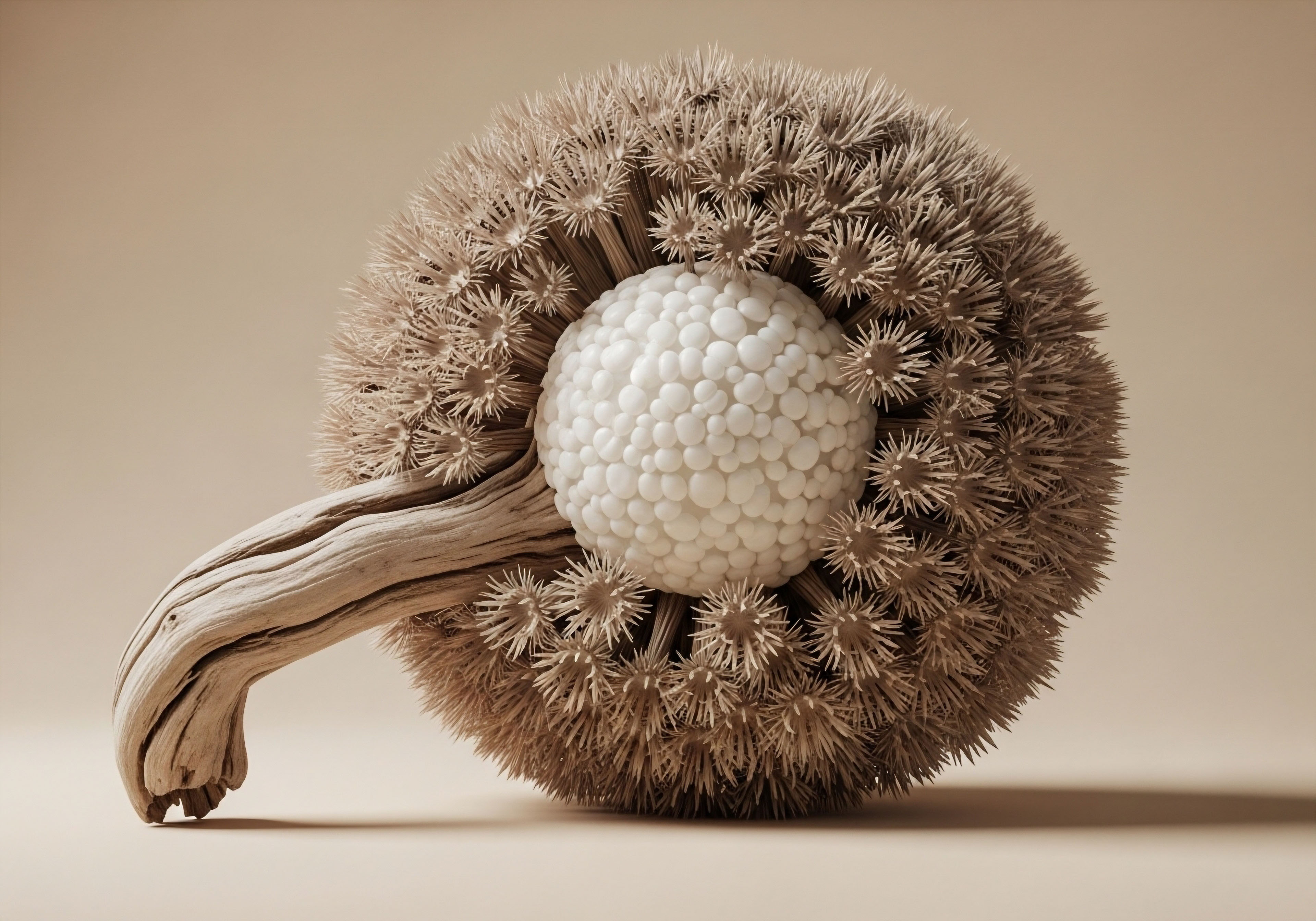

Fundamentals
The reflection in the mirror can sometimes present a stranger. The person looking back may appear tired, even when rested. The skin may seem to possess less vitality, and the lines that once appeared only with a smile now remain as a permanent map of expressions.
This experience, a silent conversation between you and your reflection, is a deeply personal one. It is a direct observation of biological changes that are occurring far beneath the surface. These alterations are not about character or the passage of time alone.
They are the physical manifestation of a shift in the body’s intricate communication network, the endocrine system. The youthful appearance of skin is a direct outcome of its structural integrity and its capacity for self-repair, processes governed with precision by hormones.
Understanding how hormonal optimization contributes to a more vibrant appearance begins with appreciating the skin as a dynamic, living organ. Its firmness, smoothness, and resilience are maintained by a microscopic architectural matrix. This matrix is composed primarily of proteins and moisture-retaining molecules, each with a specific function.
Hormones act as the project managers for this complex construction, sending signals that direct the assembly, maintenance, and repair of this vital structure. When the levels of these hormonal messengers decline, as they do with age, the instructions for maintenance become less frequent and less clear. The result is a gradual degradation of the skin’s foundational elements, leading to the visible changes associated with aging.
Hormones function as essential regulators for the skin’s structural proteins and hydration, directly influencing its texture and resilience.

The Architectural Trio of Youthful Skin
Three components are fundamental to the skin’s plump, elastic, and hydrated state ∞ collagen, elastin, and hyaluronic acid. These substances form the very fabric of the dermis, the skin’s thickest layer. Their abundance and quality are directly tied to the hormonal signals they receive. A decline in these signals is a primary driver of skin aging.

Collagen the Foundation of Firmness
Collagen is the most abundant protein in the body and provides the skin with its structural scaffolding. It is responsible for its thickness and resistance to force. The cells that manufacture collagen, known as fibroblasts, are highly responsive to hormonal instruction. Estrogen, in particular, is a potent stimulator of collagen synthesis.
When estrogen levels are optimal, fibroblasts are instructed to produce ample, high-quality collagen fibers, keeping the skin dense and firm. As estrogen levels fall during perimenopause and menopause, these instructions diminish. Studies indicate that skin can lose approximately 30% of its collagen in the first five years following menopause, a direct consequence of this reduced signaling. This loss of structural support is what leads to skin thinning and the formation of wrinkles.

Elastin the Source of Suppleness
While collagen provides firmness, elastin allows the skin to stretch and recoil. This protein gives skin its suppleness, its ability to snap back into place after being pulled or pressed. Like collagen, elastin production is also influenced by hormones. Estrogen supports the health and formation of elastin fibers.
A reduction in estrogen signaling contributes to a decrease in both the quantity and quality of these fibers. The skin becomes less resilient, leading to sagging and a loss of its defined contours. This is particularly noticeable in areas like the jawline and neck.

Hyaluronic Acid the Molecule of Moisture
Hydration is another key attribute of youthful skin, providing it with a plump and dewy appearance. Hyaluronic acid is a molecule with a remarkable capacity to bind and retain water. Estrogen plays a direct role in maintaining the skin’s hyaluronic acid content. By supporting the production of this substance, estrogen helps the skin remain hydrated from within.
When estrogen levels decline, the skin’s ability to hold onto moisture is compromised. This leads to dryness, a loss of volume, and the accentuation of fine lines. Progesterone also contributes to skin hydration by influencing oil production and moisture retention.

The Distinct Roles of Key Hormones in Skin Health
Both male and female bodies rely on a precise balance of sex hormones for systemic health, and this balance is clearly reflected in the skin’s appearance. While estrogen is a dominant force in female skin health, testosterone also has a significant impact, particularly on skin thickness and function.
In men, the gradual decline of testosterone associated with andropause also affects the skin. Testosterone is responsible for maintaining greater skin thickness in men compared to women. It achieves this by promoting collagen synthesis. As testosterone levels decrease, men may experience skin thinning, increased dryness, and the development of wrinkles.
Testosterone also stimulates the sebaceous glands to produce sebum, the skin’s natural oil. While excessive sebum can lead to acne, a healthy amount is necessary to keep the skin moisturized and protected. The hormonal shifts during andropause can alter sebum production, contributing to changes in skin texture.
In women, testosterone, though present in smaller amounts, also supports skin thickness and collagen production. Low-dose testosterone therapy in women can help maintain the skin’s structural integrity. The interplay between estrogen, progesterone, and testosterone is what creates a comprehensive support system for the skin. When this system is recalibrated through hormonal optimization, the skin receives the necessary signals to maintain its architectural components, resulting in a visibly healthier and more youthful appearance.


Intermediate
Moving from a general understanding of hormonal influence to the application of specific clinical protocols allows for a deeper appreciation of how biochemical recalibration can directly impact skin aesthetics. Hormone replacement therapy is a process of restoring the body’s signaling molecules to levels that support optimal function.
This restoration has profound effects on the skin’s cellular machinery. The protocols are tailored to an individual’s unique biochemistry, addressing the specific hormonal deficiencies that are driving visible signs of aging. This is a targeted intervention, designed to re-engage the skin’s innate capacities for repair and regeneration.

Protocols for Female Hormonal Optimization and Skin Integrity
For women, particularly those in the perimenopausal and postmenopausal stages, hormonal optimization protocols are designed to address the decline in estrogen, progesterone, and sometimes testosterone. These therapies provide the skin’s cells with the signals needed to counteract the age-related decline in structural proteins and hydration. The goal is to re-establish the biochemical environment that supports dermal health.
A common protocol for women involves the use of bioidentical hormones, which are molecularly identical to those the body produces. This can include estradiol, the most potent form of estrogen, often administered as a transdermal cream or patch. This method allows for steady absorption and minimizes the first-pass effect through the liver.
Estradiol supplementation directly stimulates the fibroblast cells in the dermis, increasing the production of both collagen and elastin. This leads to measurable improvements in skin thickness, firmness, and elasticity. Studies have shown that topical application of estrogen can significantly improve skin quality by increasing collagen content.
Progesterone is another vital component of female hormone therapy. It is typically prescribed to balance the effects of estrogen and to support overall endocrine health. Progesterone contributes to skin elasticity and hydration. It can be administered orally or as a topical cream. The inclusion of progesterone helps to create a more complete hormonal profile, addressing multiple factors that contribute to skin aging.
Low-dose testosterone therapy is also becoming a more common element of female wellness protocols. Testosterone cypionate, administered via subcutaneous injection in small, carefully calibrated doses (e.g. 10-20 units weekly), helps to maintain skin thickness and support collagen synthesis. This can be particularly beneficial for preventing the skin thinning that accelerates after menopause.
Targeted hormone therapy for women restores key signals for collagen and elastin production, directly addressing the root causes of skin thinning and loss of firmness.
| Hormone | Primary Mechanism of Action | Visible Effect on Skin |
|---|---|---|
| Estradiol | Binds to estrogen receptors on fibroblasts, stimulating the synthesis of collagen and hyaluronic acid. | Increased skin thickness, improved firmness, reduced wrinkle depth, and enhanced hydration. |
| Progesterone | Influences sebum production and supports skin elasticity. | Improved skin hydration and suppleness, contributing to a smoother texture. |
| Testosterone (low-dose) | Supports collagen density and helps maintain the structural integrity of the dermis. | Enhanced skin thickness and resilience, preventing fragility. |

Protocols for Male Hormonal Optimization and Skin Health
For men experiencing andropause, Testosterone Replacement Therapy (TRT) is the primary protocol for addressing the symptoms of hormonal decline, including changes in the skin. The standard protocol often involves weekly intramuscular injections of Testosterone Cypionate (e.g. 200mg/ml). This therapy is designed to restore testosterone levels to a healthy, youthful range, which has direct benefits for the skin.
Restoring testosterone levels helps to maintain the skin’s thickness by stimulating collagen production. This counteracts the tendency for skin to become thinner and more fragile with age. Men on TRT often notice that their skin appears firmer and more resilient. The therapy also influences sebum production, which can help to alleviate the skin dryness that sometimes accompanies low testosterone.
A comprehensive male TRT protocol often includes other medications to ensure hormonal balance and mitigate potential side effects.
- Gonadorelin ∞ This medication is administered via subcutaneous injection (e.g. twice weekly) to stimulate the body’s own production of luteinizing hormone (LH) and follicle-stimulating hormone (FSH).
This helps to maintain testicular function and supports the natural endocrine axis.
- Anastrozole ∞ This is an aromatase inhibitor, taken as an oral tablet (e.g. twice weekly). It works by blocking the conversion of testosterone into estrogen.
For skin health, this is relevant because it helps to manage the potential for hormone-related side effects by maintaining a balanced testosterone-to-estrogen ratio.
- Enclomiphene ∞ This may be included to further support LH and FSH levels, promoting a more robust and balanced endocrine environment.

The Role of Peptide Therapy in Skin Rejuvenation
Beyond direct hormonal replacement, peptide therapies represent another frontier in aesthetic and wellness medicine. Peptides are short chains of amino acids that act as precise signaling molecules. Certain peptides can stimulate the body’s own production of growth hormone (GH). As we age, GH levels decline, which contributes to some of the changes associated with aging, including decreased skin quality. Peptide therapy can help to reverse this trend.
Growth hormone peptide therapies work by stimulating the pituitary gland to release more GH. This, in turn, stimulates the liver to produce Insulin-like Growth Factor 1 (IGF-1). Both GH and IGF-1 have potent regenerative effects throughout the body, including the skin. They promote cellular repair, increase collagen synthesis, and enhance skin thickness and elasticity. This approach is considered a more natural way to elevate growth hormone levels compared to direct injections of synthetic HGH.
Commonly used peptides for this purpose include:
- Sermorelin ∞ This peptide mimics the body’s natural growth hormone-releasing hormone (GHRH), prompting the pituitary to produce and release GH in a manner that aligns with the body’s natural rhythms.
- Ipamorelin / CJC-1295 ∞ This is a powerful combination.
CJC-1295 provides a steady elevation of GH levels, while Ipamorelin provides a strong, targeted pulse of GH release. Together, they offer a synergistic effect, leading to significant improvements in skin tone, texture, and healing capacity.
- Tesamorelin ∞ This peptide is particularly effective at stimulating GH release and has been shown to have benefits for body composition and metabolic health, which indirectly supports skin vitality.
These protocols, whether based on direct hormone replacement or peptide-stimulated GH release, all operate on the same fundamental principle ∞ they restore the body’s internal communication system. By providing the correct biochemical signals, they empower the skin to rebuild its structure, retain its moisture, and function like a younger, healthier version of itself. The result is a visible improvement in appearance that is rooted in a genuine restoration of biological function.


Academic
A sophisticated examination of how hormonal therapies confer a more youthful appearance requires a deep analysis of the molecular and cellular mechanisms at play within the dermal and epidermal layers of the skin. The visible aesthetics of youth are a macroscopic reflection of microscopic homeostasis.
Hormonal optimization protocols function by directly intervening in the signaling pathways that regulate gene expression, protein synthesis, and cellular metabolism in keratinocytes, fibroblasts, and other cutaneous cell types. The connection between the endocrine system and skin vitality is mediated by a complex network of receptors and intracellular signaling cascades, which we can explore from a systems-biology perspective.

Estrogen Receptor Signaling in Dermal Fibroblasts
The primary mechanism through which estrogen exerts its profound effects on skin aging is via its interaction with specific nuclear hormone receptors ∞ Estrogen Receptor Alpha (ERα) and Estrogen Receptor Beta (ERβ). Both receptor subtypes are expressed in skin cells, including fibroblasts and keratinocytes, though their distribution and concentration vary.
Facial skin, for instance, has a higher concentration of these receptors compared to other areas of the body, which explains why the effects of hormonal decline are often most apparent on the face.
When 17β-estradiol binds to these receptors, the receptor-ligand complex translocates to the nucleus. There, it functions as a transcription factor, binding to specific DNA sequences known as Estrogen Response Elements (EREs) in the promoter regions of target genes. This binding event modulates the rate of transcription for genes involved in cutaneous health.
For example, estrogen upregulates the transcription of genes for type I and type III collagen (COL1A1, COL1A2, COL3A1). This leads to an increase in the synthesis of procollagen molecules, which are then secreted into the extracellular matrix and assembled into mature collagen fibrils. The result is a denser, more structurally sound dermis.
Furthermore, estrogen signaling appears to modulate the balance between collagen synthesis and degradation. It has been shown to decrease the expression of matrix metalloproteinases (MMPs), a family of enzymes responsible for breaking down extracellular matrix proteins like collagen. By simultaneously increasing collagen production and decreasing its breakdown, estrogen maintains a positive collagen balance, which is fundamental to preserving skin thickness and preventing wrinkle formation.
Estrogen’s binding to nuclear receptors in skin cells directly activates the genetic machinery responsible for producing collagen and inhibiting its degradation.
| Hormone/Peptide | Target Cell | Receptor/Pathway | Primary Molecular Outcome |
|---|---|---|---|
| Estradiol | Fibroblast | Estrogen Receptors (ERα, ERβ) | Upregulation of COL1A1, COL3A1 gene transcription; downregulation of MMP expression. |
| Testosterone | Fibroblast, Sebocyte | Androgen Receptor (AR) | Stimulation of procollagen synthesis; modulation of sebaceous gland activity. |
| Growth Hormone (via Peptides) | Keratinocyte, Fibroblast | GH Receptor, IGF-1 Receptor | Activation of JAK/STAT pathway; increased synthesis of IGF-1, leading to cellular proliferation and protein synthesis. |

The Hypothalamic Pituitary Somatotropic Axis and Skin Regeneration
Peptide therapies, such as those using Sermorelin or the CJC-1295/Ipamorelin combination, function by interacting with the Hypothalamic-Pituitary-Somatotropic (HPS) axis. This neuroendocrine axis governs the body’s production of growth hormone. Peptides like Sermorelin are analogues of Growth Hormone-Releasing Hormone (GHRH).
They bind to GHRH receptors on the somatotroph cells of the anterior pituitary gland. This binding event triggers an intracellular signaling cascade involving cyclic adenosine monophosphate (cAMP) and protein kinase A (PKA), which ultimately leads to the synthesis and pulsatile release of growth hormone (GH).
Once released into circulation, GH exerts its effects in two ways. It can act directly on target tissues that express the GH receptor, or it can act indirectly by stimulating the liver to produce Insulin-like Growth Factor 1 (IGF-1). Both GH and IGF-1 receptors are present on dermal fibroblasts and keratinocytes.
The binding of these ligands to their respective receptors activates intracellular signaling pathways, most notably the JAK/STAT and PI3K/Akt pathways. These pathways promote cell survival, proliferation, and protein synthesis. The activation of these pathways in fibroblasts leads to an increase in the production of extracellular matrix components, including collagen and elastin, contributing to dermal repair and rejuvenation.
This system provides a clear example of how signals originating in the central nervous system can be translated into regenerative effects in peripheral tissues like the skin.

How Do Androgens Influence Skin Structure?
Androgens, primarily testosterone and its more potent metabolite dihydrotestosterone (DHT), also play a significant role in skin physiology by binding to the androgen receptor (AR), another nuclear hormone receptor. The activation of the AR in dermal fibroblasts also promotes the synthesis of collagen, which accounts for the fact that male skin is, on average, about 20% thicker than female skin. The gradual decline in testosterone during andropause leads to a reduction in this signaling, contributing to age-related skin thinning.
In sebocytes, the cells of the sebaceous glands, androgen receptor activation stimulates lipogenesis, leading to the production of sebum. This is why TRT can sometimes lead to oilier skin or acne, as the restored testosterone levels reactivate these glands.
The clinical management of TRT, including the potential use of an aromatase inhibitor like Anastrozole, is designed to maintain an optimal balance, providing the benefits of testosterone for collagen support while managing its effects on sebaceous activity. The goal of such a protocol is to replicate a healthy, youthful endocrine state, thereby restoring the skin’s functional and aesthetic qualities from a foundational, biological level.
- Systemic Integration ∞ Hormonal therapies do not target the skin in isolation. They restore a systemic signaling environment. The improvements in sleep, metabolism, and energy that often accompany hormonal optimization also contribute to better skin health by reducing systemic stress and improving the body’s overall capacity for repair.
- Cellular Communication ∞ The aesthetic benefits of HRT are a direct result of re-establishing clear communication with the cells responsible for maintaining the skin’s structure. By providing the correct hormonal “language,” these cells are once again able to perform their functions optimally.
- Gene Expression ∞ Ultimately, these therapies work by modulating gene expression. They turn on the genes associated with youthful function and turn down the genes associated with degradation and aging. This represents a fundamental intervention in the biology of skin aging.

References
- Stevenson, S. and J. Thornton. “Effect of estrogens on skin aging and the potential role of SERMs.” Clinical interventions in aging, vol. 2, no. 3, 2007, pp. 283-97.
- Raine-Fenning, N. J. et al. “Skin aging and menopause ∞ the role of estrogen.” Journal of the American Academy of Dermatology, vol. 48, no. 1, 2003, pp. 28-33.
- Kopera, Daisy. “Impact of Testosterone on Hair and Skin.” Journal of Chemical Biology & Therapeutics, vol. 1, no. 1, 2016, pp. 1-4.
- Lephart, Edwin D. “Menopause and the Skin ∞ Old Favorites and New Innovations in Cosmeceuticals for Estrogen-Deficient Skin.” Dermatology and Therapy, vol. 10, no. 6, 2020, pp. 1239-1255.
- Walker, Richard F. “Sermorelin ∞ a better approach to management of adult-onset growth hormone insufficiency?” Clinical Interventions in Aging, vol. 1, no. 4, 2006, pp. 307-308.
- “The 2022 hormone therapy position statement of The North American Menopause Society.” Menopause (New York, N.Y.), vol. 29, no. 7, 2022, pp. 767-794.
- Snyder, P. J. et al. “Effects of Testosterone Treatment in Older Men.” The New England journal of medicine, vol. 374, no. 7, 2016, pp. 611-24.

Reflection
The information presented here provides a map of the biological territory connecting your internal chemistry to your external appearance. It details the messengers, the signals, and the cellular responses that construct the visible vitality of your skin. This knowledge shifts the conversation from one about inevitable decline to one about functional restoration. The changes you observe are not simply cosmetic; they are data points, reflecting the status of a complex internal system.
With this understanding, you can begin to view your own health journey through a different lens. The objective becomes one of achieving a state of systemic balance, where your body’s own intelligent systems are fully supported and operational. Consider what it means to align your internal biology with your desired state of well-being.
This path is a personal one, a collaboration between your lived experience and the precise application of clinical science. The ultimate goal is to achieve a state where you function with vitality, and the reflection in the mirror is a genuine expression of that inner health.



